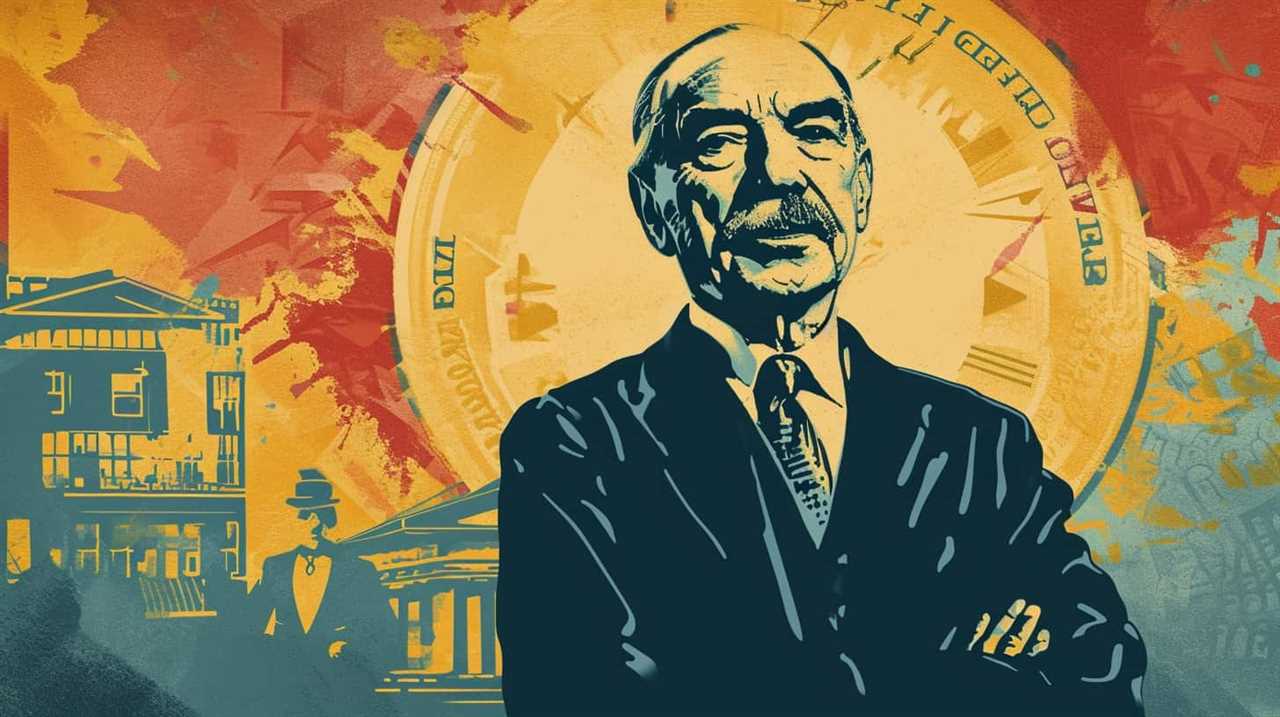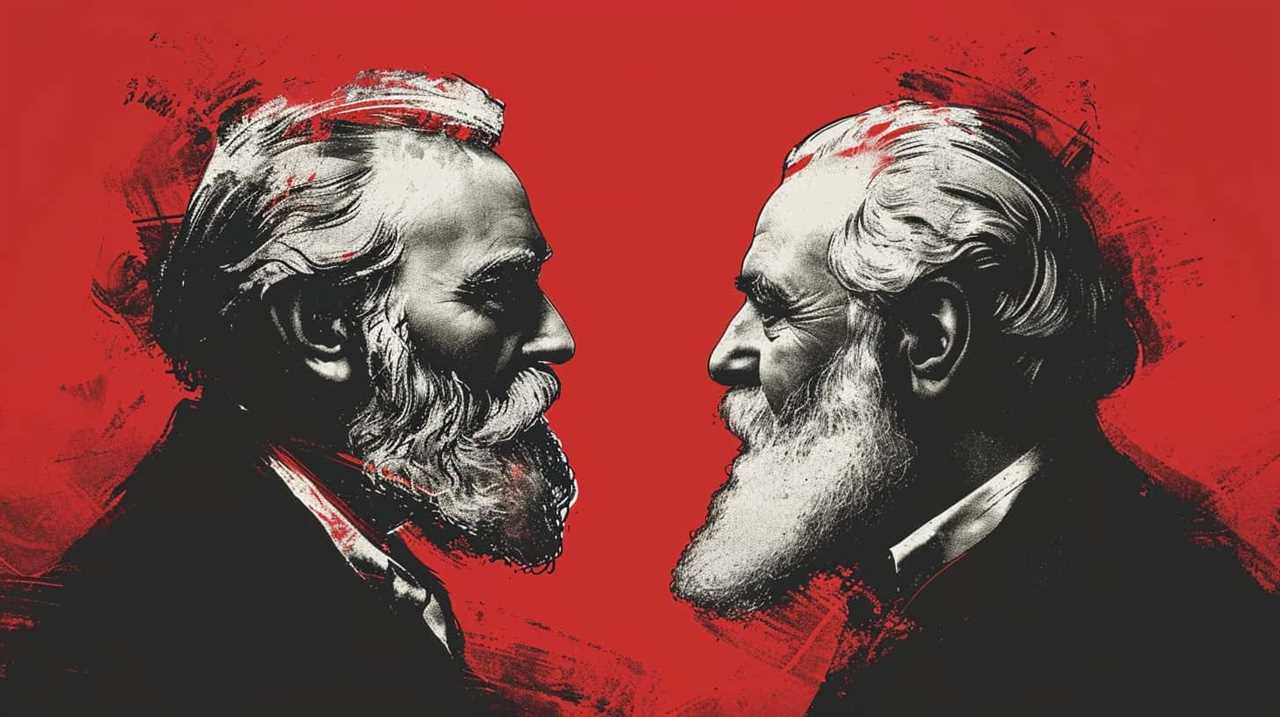Welcome to our review of the top 10 insights into the economic impact of the Invisible Hand!
Get ready to uncover the secrets behind Adam Smith’s groundbreaking concept and its impact on our modern world.
In this innovative journey, we will delve into the role of self-interest in economic decision-making, the power of market equilibrium and price signals, and the dynamic relationship between competition and innovation.
We will also examine the effect of supply and demand on prices, the delicate balance between government regulation and the Invisible Hand, and its influence on income distribution and long-term economic growth.

Brace yourselves for a thought-provoking exploration of the Invisible Hand’s economic prowess, as we uncover its strengths, limitations, and its undeniable place in shaping our innovative world.
Key Takeaways
- The concept of the Invisible Hand describes the unintended social benefits of pursuing self-interest and operates through the market mechanism.
- Self-interest and decision-making play a crucial role in the economy by providing motivation, fostering competition, and leading to efficient allocation of resources.
- Understanding market dynamics, price signals, and market equilibrium is important for businesses and policymakers.
- Government regulation is necessary to ensure market stability, address market failures, protect consumer rights, and balance economic growth and social welfare.
Adam Smith’s Invisible Hand Concept
We firmly believe that Adam Smith’s concept of the Invisible Hand has had a profound and far-reaching impact on the economy. This concept, introduced in his book ‘The Wealth of Nations,’ describes the unintended social benefits that arise from individuals pursuing their own self-interest. The Invisible Hand operates through the market mechanism, where individuals seeking to maximize their own profits unknowingly contribute to the overall welfare of society.
One of the key impacts of the Invisible Hand concept is its role in globalization. By encouraging individuals and businesses to seek out the most advantageous opportunities for trade and investment, the Invisible Hand has played a significant role in facilitating the integration of economies across the globe. This has led to increased economic interdependence, the exchange of goods and services on a global scale, and the growth of multinational corporations.
However, it’s important to consider the ethical implications of the Invisible Hand concept. While it promotes economic efficiency and growth, it also highlights the potential for income inequality and exploitation. The pursuit of self-interest can sometimes lead to externalities, such as environmental degradation or labor exploitation, that may harm society as a whole. It’s crucial for policymakers and businesses to address these ethical concerns and ensure that the benefits of the Invisible Hand are balanced with social and environmental considerations.

The Role of Self-interest in Economic Decision-making
The role of self-interest in economic decision-making is crucial for understanding the functioning of the Invisible Hand concept introduced by Adam Smith. Self-interest refers to individuals acting in a way that maximizes their own personal gain. While self-interest may seem selfish at first glance, it actually plays a vital role in promoting economic growth and social welfare.
Here are four key insights into the role of self-interest in economic decision-making:
- Incentives: Self-interest provides individuals with the motivation to seek out opportunities for economic gain. This drives innovation, entrepreneurship, and productivity, leading to economic growth and higher living standards.
- Competition: Self-interest fosters competition among individuals and firms. This competition incentivizes them to offer better products and services at lower prices, ultimately benefiting consumers and society as a whole.
- Resource allocation: Self-interested individuals make economic decisions based on their own preferences and needs. This decentralized decision-making process leads to the efficient allocation of resources, ensuring that goods and services are produced and distributed to satisfy the demands of consumers.
- Ethical considerations: While self-interest primarily focuses on personal gain, ethical considerations play a role in economic decision-making as well. Individuals and firms are motivated to act ethically to maintain their reputation, attract customers, and build trust in the market.
Understanding the role of self-interest in economic decision-making is essential for policymakers and individuals alike. By harnessing self-interest and aligning it with ethical considerations, we can promote economic growth and social welfare in innovative and sustainable ways.
Market Equilibrium and Price Signals
The market dynamics and price equilibrium play a crucial role in shaping the functioning of an economy. Market equilibrium refers to the point where the quantity demanded by consumers matches the quantity supplied by producers, resulting in a balance between supply and demand. Price signals, on the other hand, are the indicators that convey information about the scarcity or abundance of a particular good or service.

In a dynamic market, the forces of supply and demand interact to determine the equilibrium price. When demand exceeds supply, prices tend to rise, signaling to producers that there’s an opportunity for profit. In response, producers increase their output to capitalize on the higher prices, eventually restoring equilibrium. Conversely, when supply exceeds demand, prices tend to fall, prompting producers to decrease their output to avoid losses.
Understanding market dynamics and price equilibrium is crucial for businesses and policymakers. By analyzing price signals, businesses can make informed decisions about production levels, pricing strategies, and resource allocation. Policymakers, on the other hand, can use this information to design effective interventions to address market imbalances and promote economic stability.
Competition and Innovation in the Economy
In the economy, competition drives innovation through the pursuit of market dominance. When businesses compete with each other, they’re motivated to constantly improve their products and services in order to gain a competitive edge. This leads to a continuous cycle of innovation, as companies strive to develop new and better solutions to meet the changing needs of consumers.
Here are four ways in which competition and innovation in the economy can have a significant impact:

- Increased quality: In a competitive market, businesses are compelled to offer high-quality products and services to attract and retain customers. This leads to a continuous improvement in quality standards, benefiting consumers who’ve access to better options.
- Lower prices: Competition encourages businesses to find ways to reduce costs and increase efficiency. This can result in lower prices for consumers, as companies strive to offer better value for money in order to gain a competitive advantage.
- Greater choice: A competitive market encourages businesses to differentiate themselves from their competitors by offering unique products or services. This leads to a wider range of options for consumers, allowing them to choose the best fit for their preferences and needs.
- Technological advancements: In a highly competitive environment, companies invest in research and development to stay ahead of their rivals. This drives technological advancements, which can have far-reaching benefits for society as a whole.
The interplay between competition and innovation in the economy is a powerful force that drives progress and creates opportunities for growth. By understanding the dynamics of market competition and consumer behavior, businesses can harness these forces to foster innovation and drive economic development.
Effect of Supply and Demand on Prices
Price fluctuations are a direct result of the interplay between supply and demand in the market.
When demand exceeds supply, a shortage occurs, leading to an increase in prices.
Conversely, when supply surpasses demand, prices tend to decrease.

These fluctuations in prices are driven by consumers’ willingness to pay and producers’ ability to supply, highlighting the intricate relationship between supply and demand in determining market prices.
Price Fluctuations and Demand
Our observations of price fluctuations and demand reveal the significant influence of supply and demand on economic outcomes. Price elasticity, a measure of how responsive the quantity demanded is to changes in price, plays a crucial role in understanding consumer behavior. As prices fluctuate, consumers react accordingly, either increasing or decreasing their demand for a particular product. This complex relationship between price and demand can result in several emotional responses:
- Frustration: When prices of essential goods, such as food or medicine, increase, consumers may feel frustrated and burdened by the added expense.
- Excitement: Lower prices on luxury items or non-essential goods can evoke excitement and entice consumers to make purchases they might’ve otherwise delayed.
- Anxiety: Uncertainty about future price fluctuations can create anxiety and lead to cautious spending habits.
- Relief: Consumers may feel relieved when prices stabilize or decrease, allowing them to better plan their finances.
Understanding these emotional responses is crucial for businesses seeking to innovate and adapt to changing market dynamics.
As we transition into discussing the subsequent section on supply shortage and price increase, it’s important to recognize the interplay between price fluctuations and consumer demand.

Supply Shortage, Price Increase
As we delve into the topic of supply shortage and its impact on prices, it becomes evident that the availability of goods directly affects consumer demand and ultimately leads to price increases.
A shortage of supply occurs when the quantity of a product demanded by consumers exceeds the quantity available in the market. This scarcity creates a sense of urgency among consumers, driving up demand and subsequently raising prices.
The pricing dynamics in this situation can be explained by the basic principles of supply and demand. When supply is limited, the equilibrium price is driven higher as consumers are willing to pay more to secure the limited quantity of goods.
This shortage impact on pricing highlights the importance of maintaining a stable supply chain and addressing any disruptions to ensure a healthy marketplace for consumers and businesses alike.

Demand Surge, Price Inflation
The demand surge resulting from a supply shortage directly contributes to price inflation in the market. When demand exceeds supply, prices naturally increase as consumers compete for limited resources. This can lead to a variety of emotional responses in the audience, including frustration, anxiety, and even anger.
The impact of price inflation on individuals and businesses can be significant, affecting everything from daily expenses to long-term financial planning. In order to maintain market stability, it’s crucial to address supply shortages and manage demand surges effectively. By understanding the relationship between supply, demand, and prices, innovative solutions can be developed to ensure a more efficient and balanced market.
Transitioning into the next section, it’s important to explore the concept of efficiency and allocative efficiency in the market.
Efficiency and Allocative Efficiency in the Market
One key aspect of efficiency in the market is the ability of the invisible hand to allocate resources optimally. Efficiency measurement is crucial in determining whether resources are being used in the most effective way. It helps identify market failures and inefficiencies that may hinder economic growth and innovation.

Allocative efficiency refers to the optimal allocation of resources in a market. When resources are allocated efficiently, it means that they’re being allocated to their most valued uses. This leads to the maximization of societal welfare and the production of goods and services that are most in demand.
Market failures occur when the allocation of resources isn’t efficient. These failures can arise due to various reasons such as externalities, imperfect information, or the presence of monopolies. In such cases, the invisible hand may not be able to optimize resource allocation, leading to inefficiencies and potential welfare losses.
Efficiency in the market is critical for innovation. When resources are allocated efficiently, it allows for the development and adoption of new technologies, products, and services. This promotes competition and drives economic growth, leading to higher living standards and improved quality of life.
Role of Government in Regulating the Invisible Hand
When examining the role of government in regulating the invisible hand, several points come to mind.

Firstly, it’s important to consider the government’s regulatory impact on the economy and how it can shape market outcomes.
Secondly, a delicate balance must be struck between freedom and control, as excessive regulation can stifle innovation and economic growth.
Lastly, the government plays a crucial role in ensuring market stability by implementing policies that prevent market failures and address externalities.
Government’s Regulatory Impact
We play a crucial role in regulating the invisible hand’s economic influence. Government intervention and the establishment of a robust regulatory framework are essential for ensuring a fair and efficient marketplace.

Here are four key ways in which the government’s regulatory impact shapes the invisible hand:
- Consumer protection: Through regulations, we safeguard consumers from fraudulent practices, ensure product safety, and promote fair competition.
- Market stability: We implement measures to prevent market failures and mitigate risks, such as financial regulations that promote stability and prevent excessive speculation.
- Environmental sustainability: Government regulations set standards for businesses to operate in an environmentally responsible manner, reducing pollution and promoting sustainable practices.
- Social welfare: We aim to address inequality and protect vulnerable populations by implementing policies that ensure access to basic services and promote social justice.
Balancing Freedom and Control
How can the government strike a balance between freedom and control when regulating the invisible hand’s economic influence?
Balancing freedom and control in economic decision making is a delicate task for the government. On one hand, too much control can stifle innovation and hinder economic growth, while on the other hand, too much freedom can lead to market failures and exploitation.
To effectively regulate the invisible hand, the government must adopt a comprehensive approach that promotes competition and safeguards against abuses. This can be achieved by implementing transparent and fair regulations, ensuring consumer protection, promoting sustainability, and providing support for small businesses.

Ensuring Market Stability
To ensure market stability, our government must establish effective regulations that strike a balance between freedom and control in economic decision making.
Market intervention plays a crucial role in maintaining stability and protecting consumer welfare. Here are four reasons why government regulation is necessary:
- Preventing Market Failures: Government intervention can prevent market failures such as monopolies, externalities, and information asymmetry, which can harm competition and hinder innovation.
- Ensuring Fair Competition: Regulations can promote fair competition by preventing anti-competitive practices such as collusion and predatory pricing, allowing innovative businesses to thrive.
- Protecting Consumer Rights: Government regulations can safeguard consumer rights by enforcing product safety standards, ensuring accurate labeling, and preventing fraudulent practices.
- Stabilizing Financial Markets: Regulations can prevent excessive risk-taking and speculation, reducing the likelihood of financial crises and ensuring a stable and sustainable economy.
Invisible Hand and Income Distribution
The Invisible Hand directly influences income distribution within an economy. Income inequality is a pressing issue in many societies, and the concept of the Invisible Hand provides insights into its causes and potential solutions. By guiding individuals to pursue their self-interest in the marketplace, the Invisible Hand creates a system where income is determined by the value that individuals contribute to society. This leads to a natural distribution of income based on factors such as skills, education, and productivity.
However, the Invisible Hand doesn’t guarantee an equal distribution of income. In fact, it often exacerbates income inequality. Some individuals possess more resources and abilities, allowing them to earn higher incomes. This can lead to the concentration of wealth in the hands of a few, resulting in a widening income gap.

To address this issue, poverty alleviation measures become crucial. Governments and organizations can intervene by implementing policies and programs that aim to redistribute wealth and provide opportunities for those with lower incomes. These initiatives can include progressive taxation, social welfare programs, and investments in education and training. By doing so, income inequality can be reduced, and the benefits of economic growth can be shared more equitably.
In conclusion, while the Invisible Hand plays a significant role in shaping income distribution, it isn’t a guarantee of equal outcomes. Addressing income inequality requires proactive measures to alleviate poverty and promote a more equitable distribution of wealth.
Transitioning into the subsequent section, it’s important to explore the relationship between the Invisible Hand and long-term economic growth.
Long-Term Economic Growth and the Invisible Hand
When it comes to long-term economic growth, the invisible hand of the market plays a crucial role.

The concept of the invisible hand suggests that individuals pursuing their self-interests in a free market ultimately benefit society as a whole.
This leads to increased productivity, innovation, and investment, which in turn drive sustainable economic growth.
Sustainable Economic Growth
Our analysis reveals that sustainable economic growth is strongly influenced by the invisible hand. The invisible hand, guided by market forces, plays a crucial role in shaping the development of a green economy. As we strive for innovation and progress, it’s essential to consider the social responsibility aspect of sustainable growth.
Here are four key factors that evoke an emotional response in our audience:

- Conservation of natural resources: Preserving our planet for future generations.
- Reduction of carbon footprint: Mitigating the impact of climate change.
- Social inclusivity: Ensuring equal access to economic opportunities for all.
- Ethical business practices: Promoting transparency and accountability.
Unseen Market Forces
As we delve into the realm of unseen market forces, we witness the long-term economic growth driven by the invisible hand. These hidden market forces, also known as unseen market dynamics, play a crucial role in shaping the trajectory of economies.
The invisible hand concept, coined by Adam Smith, highlights the idea that individuals pursuing their self-interest in a free market ultimately benefit society as a whole. This concept has been supported by empirical evidence, showcasing how the market efficiently allocates resources and fosters innovation.
Over time, these unseen market dynamics lead to sustainable economic growth, as competition drives firms to improve productivity and create new products and services.
However, it’s important to acknowledge that the invisible hand concept also has its criticisms and limitations, which we’ll explore in the subsequent section.

Criticisms and Limitations of the Invisible Hand Concept
Despite its widespread acceptance, there are valid criticisms and limitations to the concept of the Invisible Hand. While the concept suggests that the pursuit of self-interest leads to the best outcomes for society as a whole, there are alternative theories and critiques that challenge this notion.
- Income Inequality: One criticism of the Invisible Hand concept is that it can lead to significant income inequality. When individuals are solely driven by their own self-interest, it can result in a concentration of wealth in the hands of a few, while leaving others behind.
- Market Failures: Another limitation is the occurrence of market failures. The Invisible Hand assumes that markets are efficient and will naturally correct themselves. However, in reality, there are instances when markets fail to allocate resources optimally, leading to inefficiencies and suboptimal outcomes.
- Externalities: The concept of the Invisible Hand also fails to account for externalities, which are costs or benefits that aren’t reflected in market prices. This can lead to negative consequences for society, such as pollution or social inequality, which aren’t considered in the pursuit of self-interest.
- Lack of Information: Finally, the Invisible Hand relies on the assumption that individuals have perfect information about the market. However, in reality, information is often imperfect or asymmetrical, leading to suboptimal decision-making and outcomes.
While the Invisible Hand concept has its merits, it’s important to acknowledge these criticisms and limitations in order to develop more comprehensive and innovative economic theories that address these concerns.
Frequently Asked Questions
How Did Adam Smith Come up With the Concept of the Invisible Hand?
Adam Smith’s inspiration for the concept of the invisible hand came from his observation of how individuals pursuing their self-interest in a free market system unintentionally benefit society as a whole. The invisible hand’s significance lies in its ability to promote economic efficiency and prosperity.
What Are Some Examples of Self-Interest in Economic Decision-Making?
Examples of self-interest in economic decision-making include consumers choosing products that offer the best value for their money and businesses pursuing profit maximization. Understanding the importance of self-interest helps us analyze market dynamics and foster innovation.

How Do Market Equilibrium and Price Signals Affect the Economy?
Market dynamics, influenced by the forces of supply and demand, shape the economy. Price signals and market equilibrium play a crucial role in allocating resources efficiently and guiding economic decision-making, leading to innovation and growth.
How Does Competition Drive Innovation in the Economy?
Competition dynamics in the economy serve as powerful innovation drivers. When businesses vie for market dominance, they are compelled to constantly improve and differentiate their products or services to attract customers. This leads to a continuous cycle of innovation and progress.
What Are Some Factors That Influence Income Distribution in Relation to the Invisible Hand Concept?
Factors that influence income distribution in relation to the invisible hand concept include market competition, demand and supply dynamics, technological advancements, and government policies. These factors shape the distribution of wealth and opportunity within an economy.
Conclusion
In conclusion, the concept of the invisible hand has proven itself to be a powerful force in shaping economic outcomes. Through the pursuit of self-interest, individuals and markets are able to find equilibrium and allocate resources efficiently. This has led to competition, innovation, and overall economic growth.

However, it’s important to acknowledge the limitations and criticisms of this concept, as it doesn’t account for externalities or address income inequality. Nonetheless, the invisible hand remains a fascinating and influential aspect of economic theory, guiding the invisible hand of progress.
Lauren’s talent in writing is matched by her passion for storytelling. Her love for books and deep understanding of culture and entertainment add a distinct flavor to her work. As our media and press contact, Lauren skillfully bridges the gap between afterQuotes and the broader media landscape, bringing our message to a wider audience.










